In the world of interior design, ambient lighting is often the unsung hero that transforms a space from ordinary to extraordinary. Imagine walking into a room where the lighting is so perfectly balanced that it feels like a warm embrace, inviting you to relax and unwind. This is the power of ambient lighting, the definitive guide to which will illuminate your path to creating such captivating environments.
Ambient lighting is not just about aesthetics; it plays a crucial role in our daily lives. According to a study by the American Society of Interior Designers, 68% of people are dissatisfied with the lighting in their homes, which can significantly impact mood and productivity. Understanding the nuances of ambient lighting design can lead to more harmonious living spaces and improved well-being.
As you embark on this enlightening journey, prepare to discover the art and science behind ambient lighting design. From selecting the right fixtures to mastering lighting techniques and the interplay of light and shadow, this guide will equip you with the knowledge to transform any space. Let’s dive in and explore the possibilities that await.
Understanding Ambient Lighting
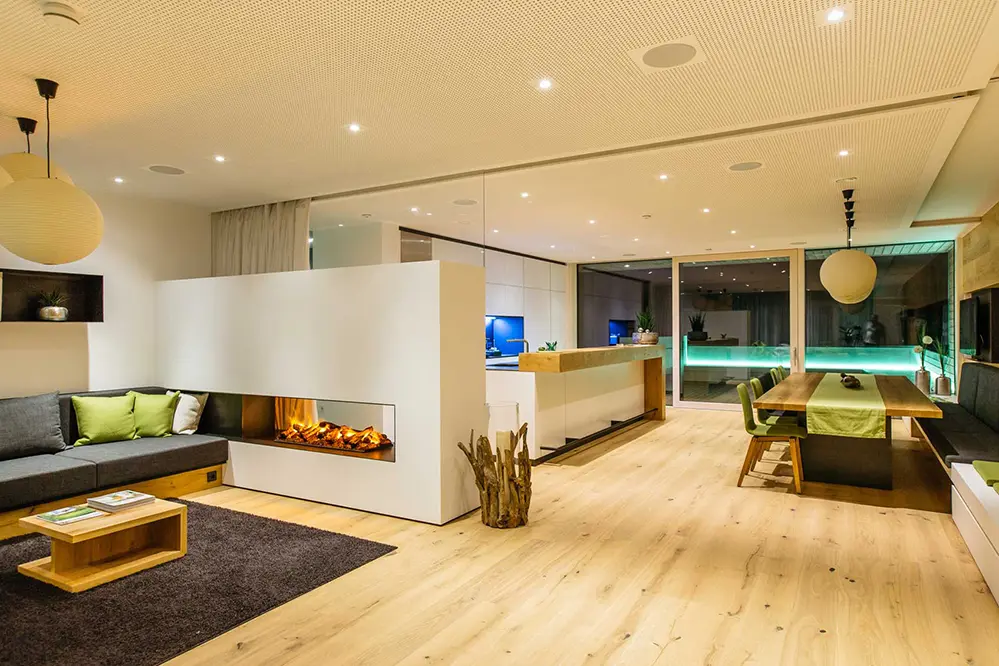
Ambient lighting serves as the cornerstone of any well-designed interior, creating a foundation of soothing illumination.
Defined by its capacity to envelop a room in a soft, uniformly distributed light, ambient lighting offers the essential backdrop to highlight your meticulously crafted space. Its beauty lies in its subtlety, providing a non-intrusive, welcoming glow that beckons you to pause and inhale the serenity of your surroundings. For many, this lighting is synonymous with home’s heartening embrace, wrapping every cherished moment in warmth.
Furthermore, ambient lighting sets a tone that influences the mood and energy of the entire space. By employing elements such as ceiling fixtures, chandeliers, or even LED strips, you craft an aura that harmonizes with your unique aesthetic, enhancing the room’s functionality and appeal.
The versatility of ambient lighting extends beyond mere illumination; it becomes a canvas on which creativity is expressed. Whether your aim is to evoke a tranquil oasis or a lively gathering space, ambient lighting provides the ultimate tool to redefine your environment, enriching your life with its transformative power and allowing your space to shine in its fullest splendor.
Benefits of Ambient Lighting
A subtle yet powerful influence.
Ambient lighting can dramatically enhance your space. The soft illumination it offers not only creates a welcoming atmosphere but can also significantly impact how you feel within a particular area. Intriguingly, it can result in the dynamics of engagement in the space being better served.
It fosters a sense of calming serenity.
Embedded in every corner, ambient light casts a flattering glow – an essential quality for any well-designed space to inspire tranquility. It’s this quality that nurtures a soothing environment while maintaining an elevated ambiance.
In turn, this foundational lighting enhances architectural and decorative elements, augmenting your interior design with a heightened emphasis on visual intrigue. Ultimately, ambient lighting embraces an environmentally conscious footprint by capitalizing on energy-efficient technologies, thus allowing you to enjoy beautifully lit spaces in a sustainable manner.
Types of Ambient Lighting
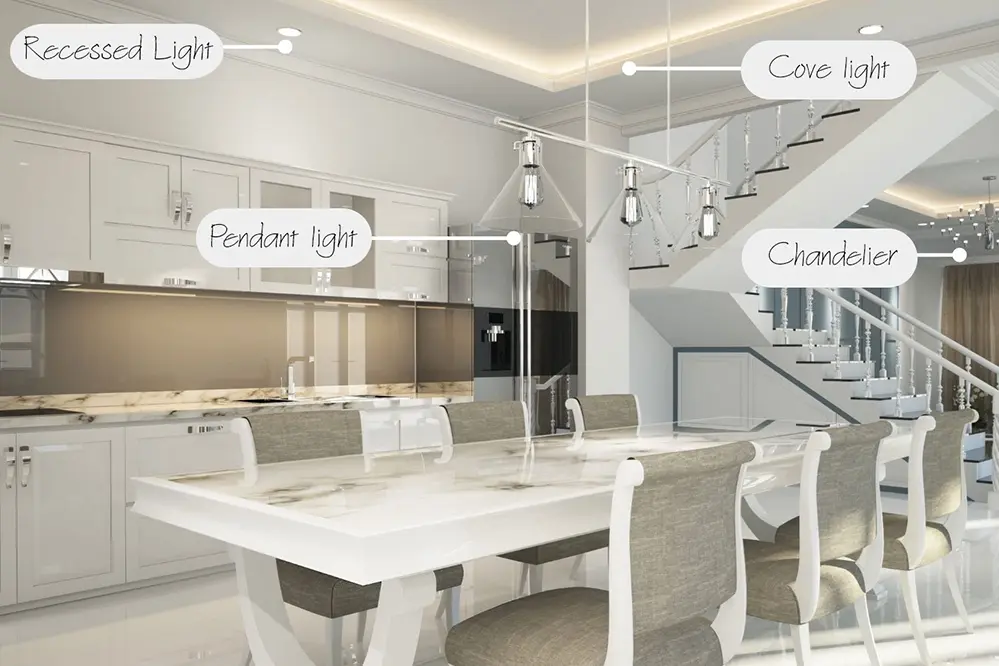
A plethora of options, including track lights, task lighting, and led strips, are available to seamlessly craft ambient lighting, each tailored to evoke distinct moods and aesthetics in any space. From recessed lighting and ceiling-mounted fixtures to the warm embrace of wall sconces, choosing the right type makes a substantial difference in the perception of your room’s ambiance.
These versatile solutions ensure you achieve a harmonious balance by combining different types to suit your lifestyle and preferences.
Natural Light
Natural light serves as a cornerstone of ambient lighting, offering an infinite source of illumination that transforms spaces. Harnessing sunlight not only reduces energy costs but also enhances well-being.
To maximize the benefits of a sunlit room, consider using light “enhancers” like mirrors. These tools act as a conduit to amplify light, illuminating even the darkest corners.
Harnessing just one hour of natural sunlight can trigger mood-boosting effects and help regulate sleep patterns.
Architectural features such as large windows and light wells can dramatically change your environment. By strategically placing reflective surfaces, you can expand light reach, making rooms appear more open and inviting. Aligning your interior design to follow the sun’s path, you ensure that every moment of daylight is captured, curating a space that resonates with vitality and warmth.
Overhead Fixtures
Overhead fixtures are a pivotal element in the pantheon of ambient lighting options, acting as a unifying source that gracefully disperses light, enveloping a room in its warm embrace. By intelligently selecting fixtures, you establish the foundation of your space’s ambiance.
Chandeliers, pendants, and flush mounts can profoundly transform your room’s atmosphere. Functional yet stylish (modern designs prioritize efficiency without compromising aesthetics), they become focal points.
Pendant lights, in particular, are versatile additions to overhead lighting schemes. With variations in size, shape, and hue, they supplement and enhance ambient lighting effortlessly.
Choosing the right overhead fixture is crucial for effective ambient illumination. It illuminates large spaces while providing a uniform luminescent layer that seamlessly blends with other lighting forms.
Consider fixtures with dimmable settings to tailor light levels, allowing control over the environment’s mood—creating vibrant energy for gatherings or tranquil repose for reflection or rest. General lighting, including overhead lighting, should adapt to your daily rhythms and occasional needs.
Ultimately, the key is finding what’s right for your space’s scale and style. Effective overhead lighting offers not just shine, but an elevated visual harmony that turns any room into a masterpiece.
Recessed Lighting
Recessed lighting offers a sleek, modern solution to infuse ambient illumination and luminescence into any space, with fixtures that are discreetly integrated into the ceiling.
These lights are perfect for creating mood-enhancing environments without taking up valuable real estate.
When opting for recessed lighting, consider strategically placing fixtures across your ceiling to craft a canopy of immersive illumination that highlights both architectural features and functional areas, seamlessly integrating form, function, and aesthetics in your environment.
One critical aspect of recessed lighting is the choice of the beam angle and bulb type; these capture your desired ambiance and optimize energy efficiency. To achieve this, invest time in “zoning” different areas with varying beam spreads and brightness levels, ensuring every corner is thoughtfully rendered.
Choosing the Right Lighting for Your Space
Selecting the perfect ambient lighting can transform the dynamics of your space, leaving it both inviting and functionally superior.
In recent years, industry advancements have expanded the repertoire of available lighting options, empowering us with choices that not only enhance aesthetic appeal but also cater to specific functional needs, across various environments and settings.
Today, it’s more vital than ever to consider lighting’s capacity to mold a space’s atmosphere, balancing both form and function. An amalgamation of direct and indirect light sources creates layers, each contributing to the overall ambiance and utility.
Assess the purpose of each room, recognizing spaces where ambient lighting isn’t just complementary but essential. From reading nooks to culinary spaces, lighting designs have evolved to cater to specific functionalities, with ample customization possibilities.
By harmonizing both natural and installed lighting elements, you’ll redefine your spatial experience, achieving both a welcoming glow and purposeful utility.
Best Practices for Setting Up Ambient Lighting
To effectively set up ambient lighting, begin by understanding the fundamental purpose and flow of each space.
First and foremost, consider employing dimmable fixtures or a smart lighting system, offering flexibility in mood creation, depending on the time of day or activity. The height and placement of light sources play an integral role in achieving uniform illumination, avoiding harsh shadows or overly bright spots. Illuminate architectural features to add depth, drawing the eye around the space appealingly while maintaining balance.
Additionally, leverage the natural light available to integrate seamlessly with artificial sources. By emphasizing warmer tones, you can mirror the cycle of daylight, fostering comfort and enhancing your environment’s intrinsic rhythm. This symbiosis helps in creating a vibrant yet calming backdrop across various settings.
Finally, pay meticulous attention to integrating ambient lighting with accent lighting for a comprehensive design approach. The interplay of different lighting layers doesn’t only beautify your space but elevates its functionality and adaptability. Thoughtfully placed lights like wall sconces or recessed fixtures can further enrich the ambiance, transforming ordinary areas into extraordinary experiences.
Ambient Lighting for Different Rooms
In a living room, ambient lighting facilitates a haven of relaxation, where both conversation and calm coexist. Strategic placement of light fixtures, like floor lamps or overhead lights, enhances comfort, making every gathering or quiet night in a delightful experience.
Each room in your home offers a new canvas for “ambient magic.” The kitchen, often thought of as utilitarian, thrives through bright and inviting lighting schemes. In home offices, the integration of ambient lighting with task lighting transforms productivity. The unique needs of these spaces dictate the style and intensity of light, ensuring each area meets its functional and aesthetic potential.
Living Room
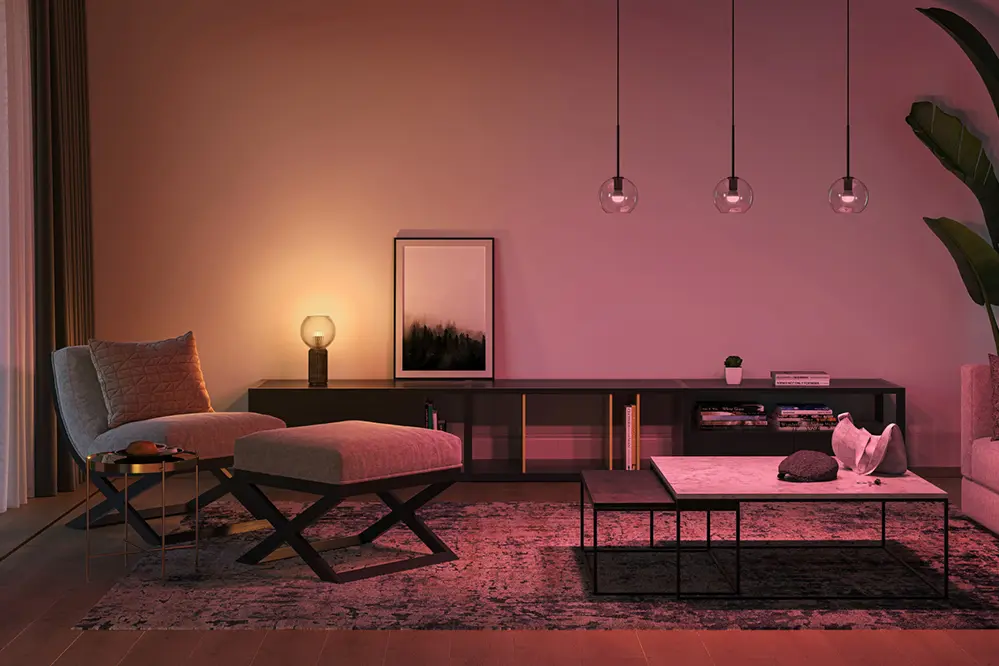
A well-designed ambient lighting scheme in the living room is key to creating an inviting and warm atmosphere.
- Floor Lamps: Offer diffuse lighting for cozy corners.
- Overhead Fixtures: Centralize illumination for balanced coverage.
- Wall Sconces: Add layers and depth to walls.
- Table Lamps: Perfect for subtle accent lighting.
- Dimmer Switches: Allow for adjustable light levels for different moods.
Integrate these elements to ensure your living room becomes a versatile haven.
These selections facilitate intimate settings or vivacious gatherings with equal ease.
Trust in the transformative power of ambient lighting to redefine your living room’s essence.
Bedroom
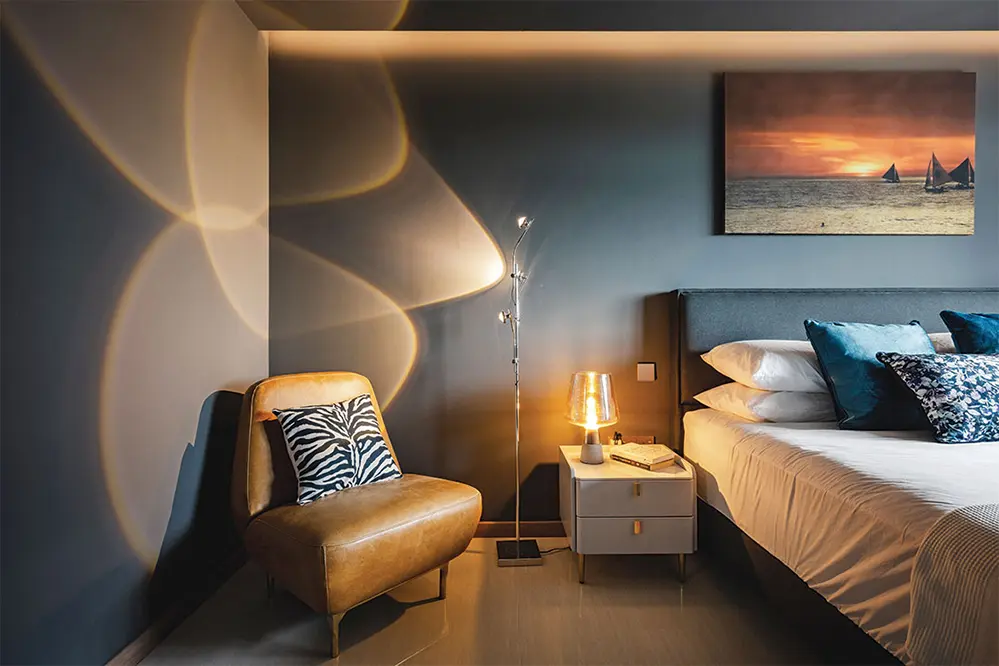
Creating a sanctuary in your bedroom starts with the perfect ambient lighting that envelops the space in tranquility, offering you a haven to unwind.
Consider soft overhead lights that mimic morning sunlight.
These can be complemented by strategically placed bedside lamps that provide a gradient of warmth, allowing you the luxury of tuning your environment for reading, meditating, or winding down at the day’s end.
A harmony of layered lighting in your bedroom not only sets the stage for restful slumber but also contributes to the room’s aesthetics as the day transitions into night. Incorporating smart lighting solutions, such as controlled dimmers or adjustable “golden” hues, invites you to immerse yourself in a soothing experience, aligning perfectly with your lifestyle needs and elevating your relaxation.
Kitchen
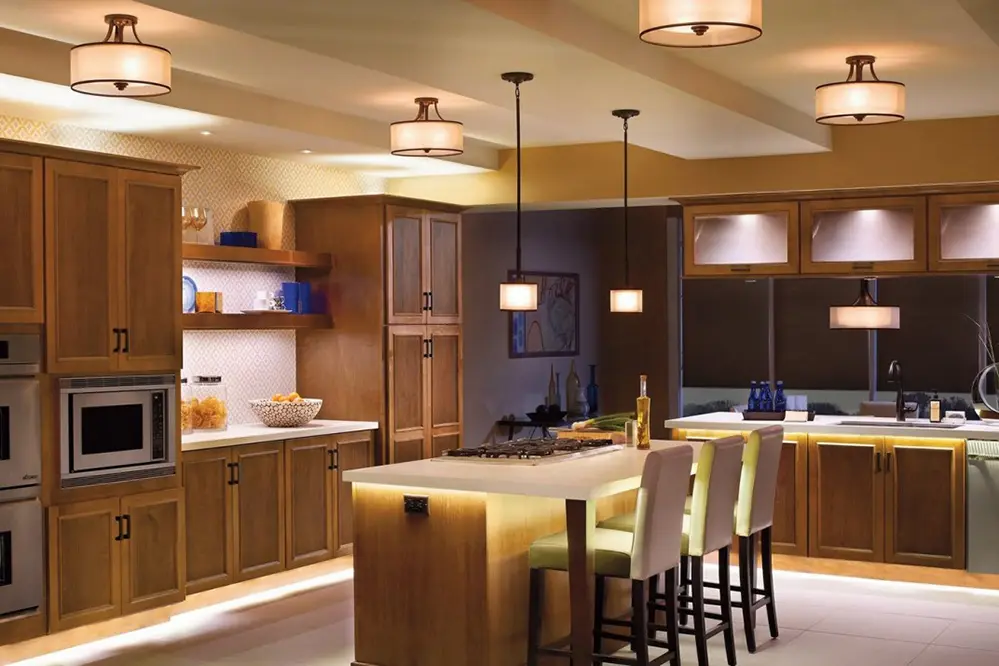
Transforming your kitchen into a beacon of elegance and functionality begins with precise ambient lighting that enhances every corner.
- Ceiling Fixtures: Opt for recessed lights or pendant fixtures for a timeless, even spread.
- Under-cabinet Lights: Illuminate countertops, ensuring tasks are performed with clarity.
- Accent Lighting: Utilize LED strips above cabinets to showcase architectural details.
- Dimmer Switches: Integrate for adjustable ambiance, harmonizing with mood and occasion.
- Smart Lighting: Implement sensors or smart bulbs for an energy-efficient, customizable environment.
Modern kitchen lighting should balance aesthetics with practical needs to create a dynamic, inviting space.
Effective ambient lighting turns your kitchen from a mere functional area to the heart of your home, infusing it with warmth and innovation.
Bathroom
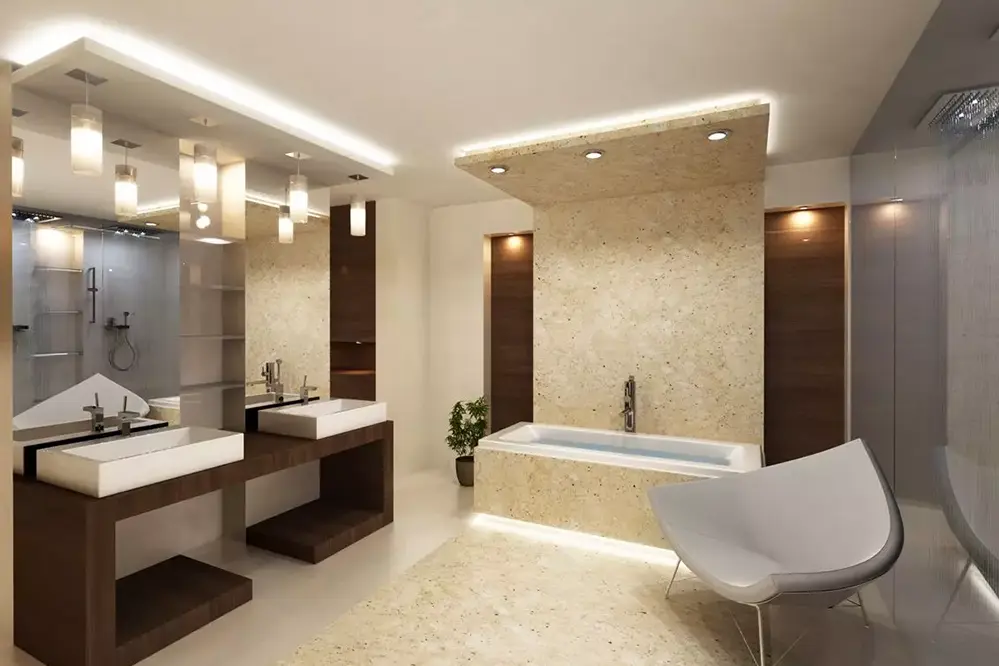
In the serene haven of your bathroom, ambient lighting enhances relaxation and rejuvenates your spirit, creating a blissful retreat.
Soft, diffused lights encourage a calming atmosphere, ideal for unwinding.
Consider integrating layered lighting to achieve optimum illumination—soft ceiling lights for a gentle glow combined with LED strips around mirrors or beneath cabinets amplify functionality and style. These illuminations balance practicality with a soothing aesthetic, crucial for a transformative bathroom experience.
Ambient lighting elevates bathrooms by adding to the space’s allure with a touch of sophistication and serenity. Consider incorporating warm lights under vanities or around bathtubs to create visual depth and an indulgent spa-like environment. By doing so, transform your everyday routine into a personal retreat and foster an environment exuding refined relaxation.
Troubleshooting Common Lighting Issues
Addressing common lighting challenges is key to ensuring that ambient lighting truly enhances your space. Flickering lights can detract from the atmosphere, making the room feel unstable and uncomfortable.
Check for loose bulbs or faulty wiring that might cause disruptions. An electrical problem can often manifest in a cycle of flickering and dimming.
Additionally, if lighting seems uneven or insufficient, consider repositioning fixtures or experimenting with dimmer switches to add flexibility to your environment. Adjusting angles or upgrading to adjustable fixtures can further help optimize light distribution.
By proactively managing these typical issues, you solidify the role of ambient lighting as a cornerstone of your space’s aesthetic and functionality. This attention to detail allows you to maintain a harmonious and inspiring environment, consistent with your vision of elegance and comfort.
Conclusion
The content highlights ambient lighting as a transformative force in design, capable of turning spaces into harmonious sanctuaries. It emphasizes that this guide makes the journey to achieving such transformation accessible, positioning ambient lighting as a key element in creating inviting environments.
Ambient lighting is portrayed as not only enhancing aesthetic appeal but also uplifting the spirit within the spaces it graces. Its transformative potential is boundless, fostering environments that nourish well-being and spark inspiration. This underscores the importance of understanding and implementing the principles and strategies outlined in the guide.
By precisely manipulating light, a room transcends its physical boundaries, becoming a canvas for human emotion and interaction. This positions ambient lighting as a powerful tool in the design arsenal, capable of transforming any space into a dynamic sanctuary filled with potential. The content encourages readers to illuminate their vision and let their spaces come alive with vibrant energy.





